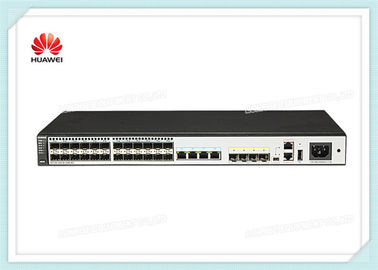|
S5720-32X-EI-24S-DC specifications
|
|
Switching Capacity
|
598 Gbit/s
|
|
Forwarding Performance
|
102 Mpps
|
|
DRAM and Flash Memory
|
SDRAM: 2 GB
|
|
Flash: 340 MB
|
|
MAC Address Table
|
64k
|
|
Fixed Ports
|
24 x 100/1,000 Base-X SFP, 4 x 10/100/1,000 Base-T, 4 x 10 Gig SFP+
|
|
Extended Slot
|
NA
|
|
DRAM and Flash
|
SDRAM: 2 GB
|
|
Flash: 340 MB
|
|
MAC Address Table
|
IEEE 802.1d
|
|
64K MAC address entries
|
|
MAC address learning and aging
|
|
Static, dynamic, and blackhole MAC address entries
|
|
Packet filtering based on source MAC addresses
|
|
VLANs
|
4K VLANs
|
|
Guest VLAN and voice VLAN
|
|
GVRP
|
|
MUX VLAN
|
|
VLAN assignment based on MAC addresses, protocols, IP subnets, policies, and ports
|
|
1:1 and N:1 VLAN mapping
|
|
VLAN-based transparent transmission of protocol packets
|
|
Jumbo Frame
|
12K
|
|
Ring Protection
|
RRPP ring topology and RRPP multi-instance
|
|
Smart Link tree topology and Smart Link multi-instance, providing millisecond-level protection switchover
|
|
Smart Ethernet Protection (SEP), G.8032 Ethernet Ring Protection Switching (ERPS)
|
|
STP (IEEE 802.1d), RSTP (IEEE 802.1w), and MSTP (IEEE 802.1s)
|
|
BPDU protection, root protection, and loop protection
|
|
BPDU tunnel
|
|
MPLS
|
MPLS L3VPN
|
|
MPLS L2VPN (VPWS/VPLS)
|
|
MPLS-TE
|
|
MPLS QoS
|
|
IP Routing
|
Static routing, RIPv1/v2, RIPng, OSPF, OSPFv3, IS-IS, IS-ISv6, BGP, BGP4+, ECMP, and policy-based routing
|
|
IPv6 Features
|
Neighbor Discovery (ND)
|
|
Path Maximum Transmission Unit (PMTU)
|
|
IPv6 Ping, IPv6 Tracert, and IPv6 Telnet
|
|
6to4 tunnel, ISATAP tunnel, and manually configured tunnel
|
|
ACLs based on source IPv6 addresses, destination IPv6 addresses, Layer 4 ports, or protocol types
|
|
Multicast Listener Discovery (MLD) v1/v2 snooping
|
|
Multicast Forwarding
|
IGMP v1/v2/v3 snooping and IGMP fast leave
|
|
Multicast forwarding in a VLAN and multicast replication between VLANs
|
|
Multicast load splitting among trunk member ports
|
|
Controllable multicast
|
|
Layer 2 multicast control
|
|
Port-based multicast traffic statistics collection
|
|
IGMPv1/v2/v3, Protocol Independent Multicast Sparse Mode (PIM-SM), and Protocol Independent Multicast Dense Mode (PIM-DM), and Protocol Independent Multicast Source-Specific Multicast (PIM-SSM)
|
|
Multicast Source Discovery Protocol (MSDP)
|
|
QoS/ACL
|
Inbound and outbound traffic rate limiting on a port
|
|
Packet redirection
|
|
Broadcast storm control
|
|
Port-based traffic policing and two-rate and three-color CAR
|
|
Eight queues per port, Weighted Round Robin (WRR), Deficit Round Robin (DRR)
|
|
Strict Priority (SP), WRR + SP, and DRR + SP queue scheduling algorithms
|
|
Weighted Random Early Detection (WRED)
|
|
Re-marking of the 802.1p priority and DSCP value of packets
|
|
Packet filtering based on Layer 2 to Layer 4 information, including source MAC addresses, destination MAC addresses, source IP addresses, destination IP addresses, TCP/UCD source/destination ports, protocol types, and VLAN IDs
|
|
Per queue rate limiting and interface traffic shaping
|
|
1:1, N:1, N:4 port mirroring
|
|
VLAN mirroring
|
|
Security Features
|
Hierarchical user management and password protection
|
|
DoS attack defense, ARP attack defense, and ICMP attack defense
|
|
Binding of the IP address, MAC address, interface number, and VLAN ID of a user
|
|
Port isolation, port security, and sticky MAC
|
|
MAC Forced Forwarding (MFF)
|
|
Blackhole MAC address entries
|
|
Limit on the number of learned MAC addresses
|
|
IEEE 802.1x authentication and the limit on the number of users on an interface
|
|
AAA authentication, RADIUS authentication, HWTACACS+ authentication, and NAC
|
|
SSH v2.0
|
|
Hypertext Transfer Protocol Secure (HTTPS)
|
|
CPU defense
|
|
Blacklist and whitelist
|
|
MACSec
|
|
Access Security
|
DHCP Relay
|
|
DHCP Server
|
|
DHCP Snooping
|
|
DHCP Client
|
|
DHCP Security
|
|
Port Aggregation
|
LACP
|
|
Up to 128 trunk groups
|
|
Up to 8 member interfaces in each trunk group
|
|
Reliability
|
Ethernet OAM (IEEE 802.3ah and 802.1ag)
|
|
ITU-Y.1731
|
|
BFD for BGP/IS-IS/OSPF/static route
|
|
Management and Maintenance
|
iStack
|
|
Virtual cable test
|
|
SNMPv1/v2c/v3
|
|
RMON/RMON2
|
|
Web-based network management system
|
|
System logs and multi-level alarms
|
|
sFlow
|
|
LLDP/LLDP-MED
|
|
Secure Copy Protocol (SCP), TFTP, FTP
|
|
Store dual software images and configuration files
|
|
802.3az Energy Efficient Ethernet (EEE)
|
|
Interoperability
|
VLAN-based Spanning Tree (working with PVST/PVST+/RPVST)
|
|
Link-type Negotiation Protocol (LNP), similar to the Dynamic Trunking Protocol (DTP)
|
|
VLAN Central Management Protocol (VCMP), similar to the VLAN Trunk Protocol (VTP)
|
|
Surge Protection
|
Surge protection capability of service ports: 6 kV
|
|
Operating Environment
|
Operating temperature:
|
|
Zero to 1,800m altitude: 0°C to 45°C
|
|
1,800m to 5,000m altitude: Operating temperature reduces by 1°C for every altitude increase of 220m.
|
|
Relative humidity: 5% to 95% (non-condensing)
|
|
Input Voltage
|
DC:
|
|
Rated voltage range: –48V to –60V
|
|
Maximum voltage range: –36V to –72V
|
|
Dimensions (W x D x H)
|
442 mm x 220 mm x 43.6 mm
|
|
Front Power Input
|
Yes
|
|
Typical Power Consumption
|
55.5W
|

 Your message must be between 20-3,000 characters!
Your message must be between 20-3,000 characters! Please check your E-mail!
Please check your E-mail!  Your message must be between 20-3,000 characters!
Your message must be between 20-3,000 characters! Please check your E-mail!
Please check your E-mail! 




